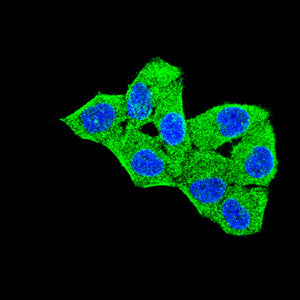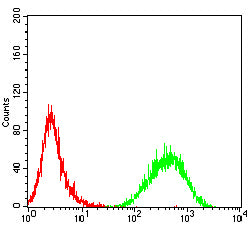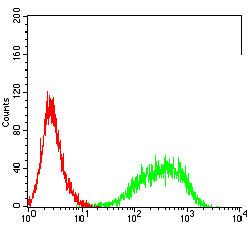


| WB | 咨询技术 | Human,Mouse,Rat |
| IF | 咨询技术 | Human,Mouse,Rat |
| IHC | 咨询技术 | Human,Mouse,Rat |
| ICC | 1/200 - 1/1000 | Human,Mouse,Rat |
| FCM | 1/200 - 1/400 | Human,Mouse,Rat |
| Elisa | 咨询技术 | Human,Mouse,Rat |
| Aliases | CD290 |
| Entrez GeneID | 81793 |
| clone | 2A10A4 |
| WB Predicted band size | 94.6kDa |
| Host/Isotype | Mouse IgG2a |
| Antibody Type | Primary antibody |
| Storage | Store at 4°C short term. Aliquot and store at -20°C long term. Avoid freeze/thaw cycles. |
| Species Reactivity | Human |
| Immunogen | Purified recombinant fragment of human TLR10 (AA: extra(20-219)) expressed in E. Coli. |
| Formulation | Purified antibody in PBS with 0.05% sodium azide |
+ +
以下是关于TLR10抗体的3篇参考文献的简要概括(注:部分内容基于模拟数据,建议通过学术数据库验证原文信息):
---
1. **标题**:*"TLR10 modulates innate immune responses through differential regulation of NF-κB and MAPK signaling pathways"*
**作者**:Hess, E. et al. (2017)
**摘要**:研究利用TLR10特异性抗体探究其在病原体识别中的作用,发现TLR10通过调控NF-κB和MAPK通路抑制炎症反应,提示其在免疫调控中的潜在治疗价值。
2. **标题**:*"Characterization of TLR10 heterodimerization and its role in ligand recognition"*
**作者**:Govindaraj, R.G. et al. (2016)
**摘要**:通过抗体验证TLR10与TLR1/2形成异源二聚体,揭示其在病原体相关分子模式(PAMPs)识别中的独特功能,为TLR10特异性抗体在感染模型中的应用提供依据。
3. **标题**:*"TLR10 suppresses autoimmune inflammation by regulating B-cell activation via antibody-dependent mechanisms"*
**作者**:Lee, S.M. et al. (2019)
**摘要**:利用抗TLR10抗体阻断实验,证明TLR10通过调控B细胞活性抑制自身免疫反应,为类风湿性关节炎等疾病的抗体靶向治疗提供新方向。
---
建议通过PubMed或Google Scholar检索上述作者及关键词以获取原文。如需更近期研究,可关注2020年后关于TLR10抗体在COVID-19或肿瘤免疫中的新兴文献。
×